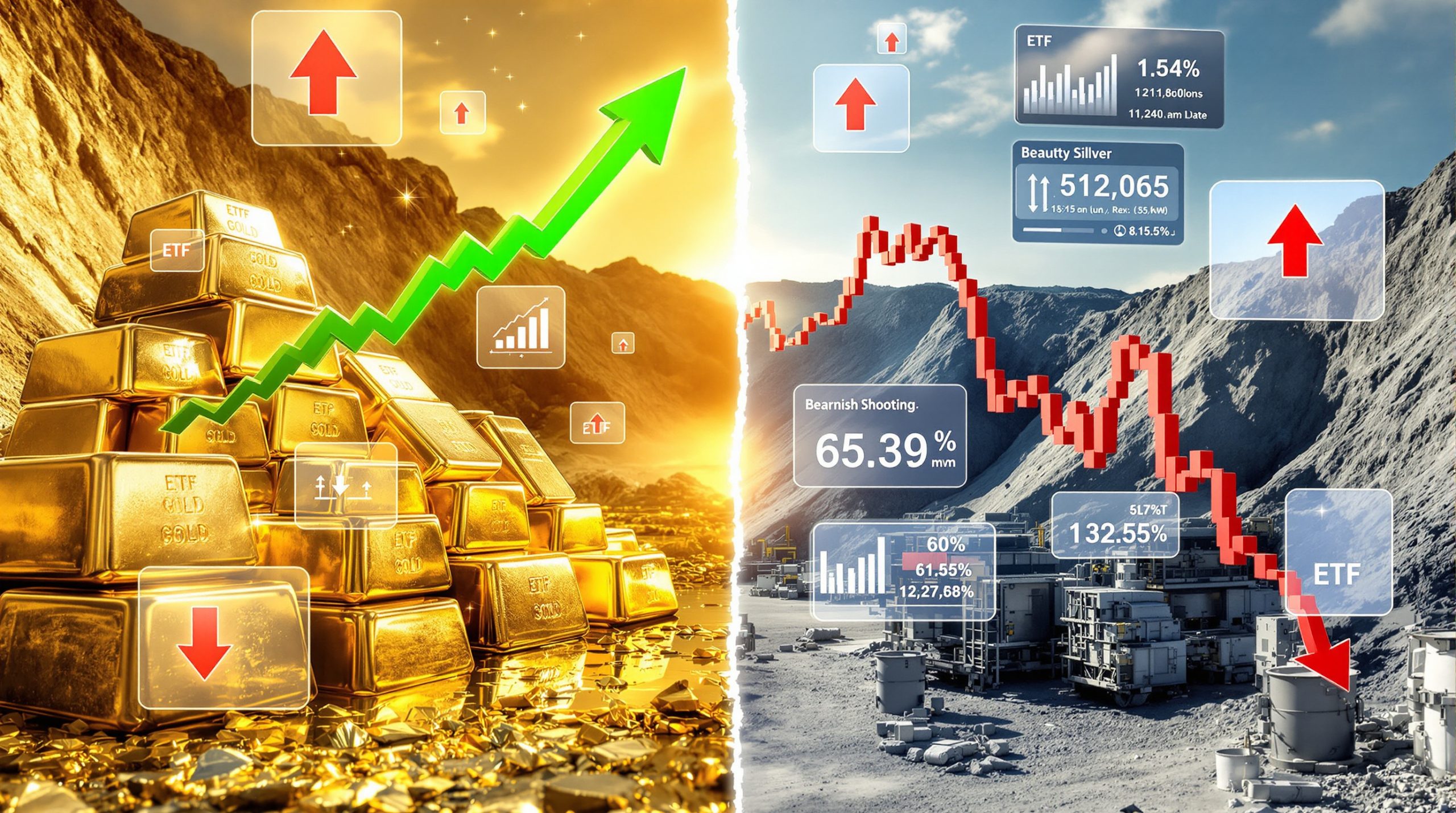Macro Factors Driving Silver Prices: Economic Indicators, Supply-Demand Dynamics, and Market Outlook
What Are the Key Macro Factors Influencing Silver Prices in 2025?
The silver market is currently experiencing a significant shift driven by macroeconomic developments that have created a distinctive pricing environment. According to the latest data from Shanghai Metal Market (SMM), several critical indicators are shaping the precious metal's trajectory.
Economic Indicators Shaping Silver's Performance
The U.S. employment landscape has taken a notable turn, with the ADP employment report revealing that private sector employment declined in June 2025—marking the first drop in over two years. This unexpected weakening in the labor market has immediately influenced market sentiment regarding Federal Reserve policy.
"This surprising employment contraction has significantly altered market expectations regarding the Fed's rate decision timeline," notes SMM's July 2025 market analysis. "The probability of a September rate cut has increased substantially following this data release."
The relationship between employment figures and silver pricing follows a clear mechanism: weaker labor data increases expectations for dovish Fed policy, which reduces the opportunity cost of holding non-yielding assets like precious metals, thereby boosting demand.
The dollar's strength has historically maintained an inverse correlation with silver prices. When the greenback weakens—as often happens when rate cut expectations rise—silver typically benefits as it becomes more affordable for holders of other currencies. This relationship is one of the key macro factors boost silver prices during periods of economic uncertainty.
Monetary Policy Developments
Federal Reserve policy remains the dominant force in the precious metals landscape. The aforementioned employment data has accelerated expectations for a September 2025 rate cut, creating a supportive environment for silver despite physical demand challenges.
The current interest rate environment across major economies continues to evolve, with diverging paths between central banks creating arbitrage opportunities and influencing capital flows toward precious metals markets. These dynamics are particularly important for the silver market squeeze analysis that many investors are closely following.
Market Reality: The combination of softening employment data and growing rate cut expectations has created a floor for silver prices even as physical demand remains subdued—demonstrating the power of macroeconomic factors over consumption patterns in the short term.
While many investors focus solely on the Federal Reserve, it's worth noting that central bank precious metal purchasing patterns have shifted dramatically in recent years. Several emerging market central banks have increased their silver holdings alongside gold as part of broader reserve diversification strategies.
How Does the Futures-Spot Price Relationship Impact Silver Markets?
The relationship between futures and spot prices provides critical insight into market expectations and physical demand conditions. Recent data reveals important shifts in this dynamic.
Current Spot-Futures Price Spread Analysis
According to SMM's July 2025 market report, the silver market is experiencing a notable narrowing of the spot-futures price differential. This convergence carries significant implications for traders and industrial users alike.
Warrant suppliers in Shanghai have reduced Trading Day (TD) premiums by 1-2 yuan/kg, signaling weakening physical demand. More dramatically, some suppliers have begun offering discounts of 36 yuan/kg against SHFE silver 2510 futures contracts.
The widening futures discounts (particularly the 36 yuan/kg figure against SHFE 2510 contracts) indicate stronger futures prices relative to spot—potentially signaling a shift toward contango in the market structure. This type of price curve typically suggests adequate or even excessive near-term supply.
Manufacturer Pricing Strategies
Large manufacturers have adapted their pricing strategies to the evolving market conditions. SMM reports they are offering premiums of 3-4 yuan/kg against TD or discounts of 13-15 yuan/kg against SHFE silver 2508 futures contracts.
This manufacturer pricing behavior reveals several important dynamics:
- Manufacturers maintain minimal premiums to cover production costs
- The willingness to accept discounts against futures contracts indicates pressure to move inventory
- The varying premium/discount structure across different contract months highlights temporal market expectations
The current price structure presents potential arbitrage opportunities for sophisticated market participants who can simultaneously operate in physical and futures markets, particularly given the regional variations in premiums and discounts.
What's Happening in Global Silver Export Markets?
International silver trading conditions provide a broader perspective on global supply-demand dynamics that complements domestic market insights.
International Silver Trading Conditions
The export market data from Hong Kong reveals concerning weakness in international demand. According to SMM's July analysis, small silver ingots are trading at a discount of 29¢/oz, while standard silver ingots are offered at a discount of 17¢/oz.
These negative premiums (effective discounts) strongly indicate oversupply or weak international demand. When exporters accept prices below benchmark levels, it typically signals their urgency to clear inventory despite unfavorable pricing.
Regional premium variations across major trading hubs create opportunities for geographic arbitrage, though successful execution requires deep understanding of logistics, regulatory requirements, and financing costs. Recent silver squeeze movement insights suggest these arbitrage opportunities may increase as market dislocations intensify.
Global Supply Chain Considerations
International shipping costs significantly impact silver pricing, with freight rates creating effective barriers between regional markets. Recent increases in container shipping costs have compressed margins for cross-border silver traders.
The regulatory landscape for precious metals continues to evolve, with several jurisdictions implementing stricter reporting requirements and verification procedures for large silver transactions. These regulatory changes can create temporary market inefficiencies as participants adjust to new compliance frameworks.
Currency fluctuations add another layer of complexity to international silver trade. The relative strength of the USD against trading partners' currencies directly impacts effective silver prices when converted to local currencies for industrial users.
How Is Consumption Affecting Silver Market Dynamics?
Physical demand patterns provide essential context for understanding price movements, particularly when divergences emerge between financial and industrial markets.
Current Consumption Patterns
SMM reports that "after the silver price increase, downstream buyers became cautious again," highlighting the price sensitivity of industrial users. This behavior demonstrates classic demand elasticity, where higher prices trigger reduced consumption.
The overall end-use consumption remained sluggish in the first half of July 2025, according to the same market analysis. This weakness in physical demand creates a paradoxical situation where prices maintain support from macro factors boost silver prices despite limited industrial buying interest.
Seasonal factors may be partially responsible for current consumption patterns, as many industries experience cyclical demand shifts during summer months. Historical patterns suggest potential consumption recovery entering Q3 and Q4.
Industrial Demand Analysis
The electronics sector represents approximately 25% of silver demand, with circuit boards, semiconductors, and other components requiring silver's unique conductivity properties. Recent electronics manufacturing PMI data suggests moderating growth in this segment.
Solar panel manufacturing has emerged as a key driver of silver demand, with photovoltaic applications consuming over 100 million ounces annually. The sector's growth trajectory remains strong despite periodic fluctuations tied to subsidy programs and installation cycles.
Medical and pharmaceutical applications, while representing a smaller share of overall demand, maintain consistent consumption patterns due to silver's antimicrobial properties. This sector shows particular resilience during economic downturns.
Emerging industrial applications, including advanced battery technologies and specialized coatings, represent growing demand sources that may become increasingly significant in coming years. These new applications could alter long-term supply-demand dynamics.
What Technical Factors Are Influencing Silver Price Movements?
Technical analysis provides valuable insight into market sentiment, positioning, and potential price trajectories based on historical patterns and trader behavior.
Chart Patterns and Technical Indicators
Silver's price structure reveals several key support and resistance levels that traders are monitoring closely. The $30 level has emerged as significant psychological resistance, while support has formed around previous consolidation zones near $27.
Multiple technical indicators suggest silver may be approaching overbought territory on daily timeframes, with relative strength indicators above 70 in early July. However, weekly momentum measures continue to show strength, creating a mixed technical picture.
Volume patterns during recent price movements have shown increasing participation during rallies and decreasing volume during pullbacks—a pattern typically interpreted as supporting the prevailing uptrend. Understanding these patterns is crucial for developing effective silver squeeze price strategies in the current market environment.
Market Sentiment Metrics
Trader positioning data from the Commodity Futures Trading Commission (CFTC) reveals that speculative long positions have increased to multi-month highs, raising the potential for a correction if these positions begin unwinding.
Options market sentiment indicators show an interesting skew toward out-of-the-money calls, suggesting traders are positioning for potential upside breaks rather than downside protection—a generally bullish signal despite near-term overbought conditions.
Social media sentiment analysis for silver shows growing retail interest coinciding with macro developments, particularly Federal Reserve policy expectations. This attention creates potential for increased volatility as retail flows respond to headline news.
How Do Investment Flows Impact Silver Pricing?
Investment demand often drives significant price movements independent of industrial consumption patterns, creating important divergences that inform trading strategies.
Investment Demand Trends
ETF holdings represent a key barometer of institutional interest in silver. Recent weeks have seen modest inflows after several months of outflows, potentially signaling renewed investor confidence in the precious metal's prospects.
Physical silver investment demand has shown regional variations, with stronger buying in Asian markets compared to Western markets through mid-2025. This geographic disparity creates interesting dynamics in premium structures across different markets.
The retail investor segment has demonstrated particular sensitivity to inflation narratives and Federal Reserve policy shifts. The recent employment data and rate cut expectations have reignited interest among this investor cohort, especially in light of concerns about the US economy and inflation trajectory.
Comparative Investment Analysis
The gold-silver ratio analysis shows that this closely watched metric among precious metals investors has compressed toward historical averages after reaching extreme levels during previous market dislocations. This normalization suggests balanced relative performance expectations.
Silver has outperformed many other commodity classes year-to-date, benefiting from both its industrial applications during the ongoing energy transition and its monetary characteristics during periods of economic uncertainty.
As an inflation hedge, silver has historically demonstrated effectiveness during periods of currency debasement and negative real yields—conditions that many analysts anticipate as central banks pivot toward accommodative policy.
What's the Outlook for Silver Prices in the Coming Months?
Forecasting silver prices requires integrating supply-demand fundamentals with macroeconomic factors and investor sentiment across multiple timeframes.
Short-term Price Projections
Technical analysis suggests silver may experience consolidation in the immediate term, with potential resistance at recent highs and support at the 50-day moving average. Any significant breakout above resistance could target the next psychological level at $35.
Several key economic events could trigger substantial price movements in coming weeks, particularly Federal Reserve communications, inflation data, and additional employment reports that might confirm or challenge the recent weak ADP figures.
Seasonal patterns suggest August typically brings reduced trading volumes and increased volatility, creating conditions for short-term price swings that may not reflect fundamental changes.
Long-term Market Fundamentals
Mining production forecasts suggest constraints in silver supply growth, with few major new projects entering production and existing operations facing grade decline and increased production costs.
Industrial demand growth projections remain robust, particularly from solar panel manufacturing, which is expected to consume increasing silver volumes as global renewable energy targets accelerate installation rates.
The technological landscape continues to evolve, with competing forces influencing silver usage. While miniaturization reduces silver content in some applications, new technologies in renewable energy, electronics, and healthcare create expanding demand sources.
Disclaimer: The forecasts presented reflect current market conditions and available information. Actual price movements may differ significantly due to unforeseen economic developments, geopolitical events, or technological disruptions. Investors should conduct their own research and consider their individual risk tolerance before making investment decisions.
FAQ About Silver Market Dynamics
What is causing the current disconnect between silver prices and physical demand?
The divergence between price strength and physical demand weakness stems primarily from investment flows driven by macroeconomic expectations. The anticipation of Federal Reserve rate cuts following weak employment data has created financial demand for silver as a non-yielding asset, even as industrial consumers exhibit caution.
This disconnect highlights silver's dual nature as both an industrial metal and a monetary asset. During periods of changing monetary policy expectations, the investment characteristics often dominate price formation despite countervailing signals from physical markets.
The current market structure—with export discounts of 29¢/oz in Hong Kong and cautious downstream buying—clearly signals physical surplus. However, speculative positioning based on macro narratives has provided a counterbalance that maintains price support.
How do changes in U.S. employment data affect silver prices?
Employment data influences silver prices through a clear transmission mechanism:
- Labor market weakness → Reduced economic growth expectations
- Growth concerns → Federal Reserve dovishness
- Anticipated rate cuts → Lower real yields
- Reduced opportunity cost → Increased precious metals appeal
The June 2025 ADP employment report exemplifies this relationship, with the first private-sector job decline in over two years immediately boosting silver prices as markets priced in higher probability of September rate cuts.
Historically, silver has shown particular sensitivity to labor market surprises, often exhibiting greater volatility than gold following significant employment data deviations from consensus expectations.
What is the significance of the spot-futures price spread in silver markets?
The spot-futures spread serves as a crucial indicator of market conditions, with several important implications:
- Contango (futures premium to spot): Typically indicates adequate supply and storage costs
- Backwardation (spot premium to futures): Often signals immediate physical shortage
- Spread narrowing: Suggests changing market expectations or physical demand patterns
The current narrowing of spreads reported by SMM, coupled with warrant suppliers reducing TD premiums by 1-2 yuan/kg, indicates weakening physical demand despite macro-supported prices.
Traders can leverage spread dynamics to identify potential market imbalances before they manifest in outright price movements. The current spread structure suggests potential vulnerability if investment flows reverse despite already weak physical demand.
How does silver compare to other precious metals as an investment in 2025?
Silver occupies a unique position among precious metals due to its substantial industrial demand component—approximately 50% of consumption versus gold's 10-15%. This industrial exposure creates both opportunities and risks compared to other metals.
In performance terms, silver has demonstrated higher volatility than gold but lower volatility than platinum group metals year-to-date. This volatility profile reflects silver's hybrid nature between monetary and industrial metals.
From a supply perspective, silver faces fewer constraints than platinum and palladium, which rely heavily on geographically concentrated production. However, silver's significant byproduct status (often produced alongside copper, lead, and zinc) means its supply can be influenced by base metal mining economics.
On a risk-adjusted return basis, silver has historically offered higher potential upside during bull markets but greater drawdowns during corrections compared to gold. This pattern has continued in 2025, with silver exhibiting both stronger rallies and deeper pullbacks than its more monetary-focused counterpart.
Silver Market Data Summary
| Indicator | Current Value | Recent Trend | Significance |
|---|---|---|---|
| Shanghai TD Premium | -1 to -2 yuan/kg | Declining | Indicates weakening physical demand |
| SHFE 2510 Discount | -36 yuan/kg | Widening | Suggests futures market strength vs. spot |
| Hong Kong Small Ingots | -29¢/oz | Negative | Export market weakness |
| Hong Kong Standard Ingots | -17¢/oz | Negative | Premium deterioration in key trading hub |
| Manufacturer Premium vs TD | +3-4 yuan/kg | Stable | Production costs maintaining minimum spreads |
| Manufacturer Discount vs SHFE 2508 | -13-15 yuan/kg | Widening | Manufacturers accepting lower margins |
Market Insight: The combination of macroeconomic tailwinds from potential Fed rate cuts and weakening physical demand creates a complex market dynamic where price support comes primarily from investment flows rather than industrial consumption. This disconnect between financial and physical markets requires careful monitoring as it may lead to increased volatility if these forces begin to realign.
Further Exploration
The divergence between macro-driven investment flows and physical market fundamentals creates a fascinating case study in silver market dynamics. This dichotomy highlights the importance of monitoring both monetary policy developments and industrial consumption patterns to form a complete market perspective.
Investors seeking to navigate this complex environment should pay particular attention to upcoming Federal Reserve communications, employment data, and physical premium trends across major trading hubs. The interplay between these factors will likely determine silver's trajectory through the remainder of 2025.
For those interested in deepening their understanding of silver market mechanics, daily market updates from specialized sources like Shanghai Metal Market provide valuable insights into evolving conditions across global trading centers.
Want to Discover the Next Major Mining Opportunity?
Stay ahead of the market with Discovery Alert's proprietary Discovery IQ model, which provides instant notifications on significant ASX mineral discoveries before they make headlines. Explore our discoveries page to see how early identification of major mineral finds can lead to exceptional investment returns.




